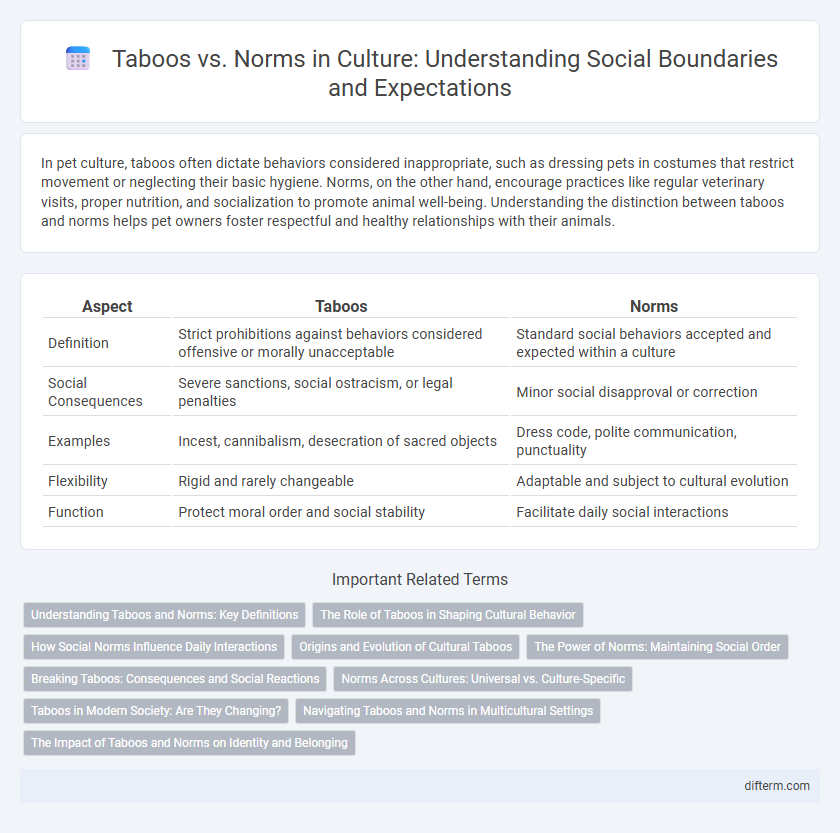In pet culture, taboos often dictate behaviors considered inappropriate, such as dressing pets in costumes that restrict movement or neglecting their basic hygiene. Norms, on the other hand, encourage practices like regular veterinary visits, proper nutrition, and socialization to promote animal well-being. Understanding the distinction between taboos and norms helps pet owners foster respectful and healthy relationships with their animals.
Table of Comparison
| Aspect | Taboos | Norms |
|---|---|---|
| Definition | Strict prohibitions against behaviors considered offensive or morally unacceptable | Standard social behaviors accepted and expected within a culture |
| Social Consequences | Severe sanctions, social ostracism, or legal penalties | Minor social disapproval or correction |
| Examples | Incest, cannibalism, desecration of sacred objects | Dress code, polite communication, punctuality |
| Flexibility | Rigid and rarely changeable | Adaptable and subject to cultural evolution |
| Function | Protect moral order and social stability | Facilitate daily social interactions |
Understanding Taboos and Norms: Key Definitions
Taboos are deeply ingrained prohibitions within a culture that evoke strong emotional reactions and social sanctions if violated, often related to moral or sacred beliefs. Norms represent the unwritten rules and expectations that guide everyday behavior, promoting social order and cohesion. Understanding these concepts is essential for analyzing cultural dynamics and the ways societies regulate acceptable conduct.
The Role of Taboos in Shaping Cultural Behavior
Taboos play a critical role in shaping cultural behavior by delineating prohibited actions that maintain social order and cohesion. These deeply ingrained prohibitions often address subjects related to morality, religion, and social harmony, influencing individual conduct and group dynamics. By reinforcing collective values and discouraging deviant behavior, taboos help preserve cultural identity and continuity within communities.
How Social Norms Influence Daily Interactions
Social norms dictate acceptable behavior within a culture, shaping daily interactions by establishing unwritten rules that guide communication, gestures, and social roles. These norms influence everything from greetings and dress codes to decision-making and conflict resolution, ensuring social cohesion and predictability. Violations of social norms often trigger subtle sanctions or social exclusion, reinforcing conformity and maintaining cultural stability.
Origins and Evolution of Cultural Taboos
Cultural taboos originate from ancient social, religious, and environmental factors that shaped collective behavior and survival strategies within communities. Over time, these prohibitions evolved through oral traditions, rituals, and societal enforcement to regulate actions deemed harmful or disruptive. The evolution of taboos reflects shifting values and adaptive mechanisms that maintain social cohesion and cultural identity across generations.
The Power of Norms: Maintaining Social Order
Norms serve as unwritten rules shaping daily behavior and reinforcing cultural values, creating predictable social patterns that maintain order within communities. Unlike taboos, which prohibit specific actions due to moral or cultural beliefs, norms guide acceptable conduct and ensure cohesion by aligning individual actions with collective expectations. The power of norms lies in their subtle enforcement through social approval or sanctions, fostering stability and cooperation across diverse social settings.
Breaking Taboos: Consequences and Social Reactions
Breaking cultural taboos often results in severe social consequences, including ostracism, stigma, and loss of social status, reflecting the collective enforcement of community values. Social reactions to taboo violations vary across societies but frequently involve public shaming, legal penalties, or informal sanctions aimed at reaffirming group cohesion and normative boundaries. Understanding these dynamics is crucial for analyzing how cultures maintain order and manage deviance through both explicit norms and deeply ingrained taboos.
Norms Across Cultures: Universal vs. Culture-Specific
Norms across cultures demonstrate both universal patterns, like prohibitions against murder or stealing, and culture-specific practices shaped by historical, social, and religious factors. While universal norms provide a shared framework for acceptable behavior, culture-specific norms reflect the unique values and traditions of individual societies. Understanding this distinction is crucial for cross-cultural communication and fostering respect in global interactions.
Taboos in Modern Society: Are They Changing?
Taboos in modern society are evolving as globalization and digital communication challenge traditional boundaries, leading to increased questioning and redefinition of previously rigid prohibitions. Topics once considered strictly off-limits, such as mental health and sexuality, are now more openly discussed, reflecting shifting cultural attitudes and greater acceptance. Despite this, some taboos persist strongly due to deep-rooted cultural, religious, or social values, demonstrating that change is uneven across different societies.
Navigating Taboos and Norms in Multicultural Settings
Navigating taboos and norms in multicultural settings requires deep cultural awareness and sensitivity to avoid misunderstandings and foster respectful interactions. Recognizing that taboos are culturally specific prohibitions while norms are socially accepted behaviors helps individuals adapt communication styles and social conduct appropriately. Effective cross-cultural competence hinges on understanding these distinctions to build trust and collaboration in diverse environments.
The Impact of Taboos and Norms on Identity and Belonging
Taboos and norms serve as foundational elements shaping individual and collective identity by delineating acceptable behaviors within cultural groups. Violations of taboos often result in social ostracism, reinforcing group cohesion and influencing personal belonging. Norms, as shared expectations, guide everyday interactions and affirm cultural membership, directly impacting how individuals perceive themselves within their community.
taboos vs norms Infographic

 difterm.com
difterm.com